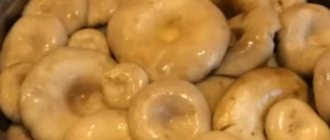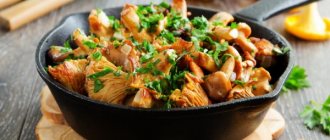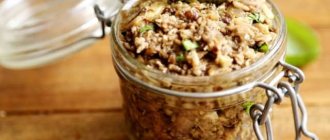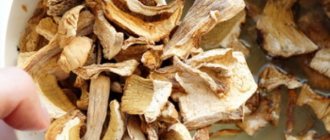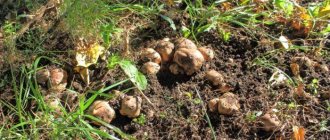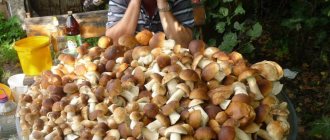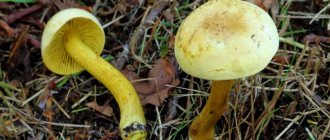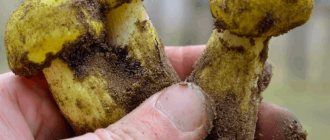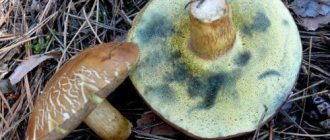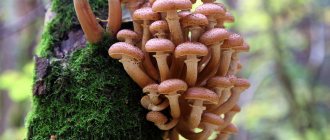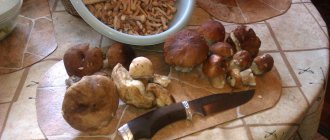Polish mushroom (pansky, brown, chestnut flywheel) is a type of mushroom belonging to the Boletaceae family, the genus Borovik. This species received its name due to massive export from Poland to Western Europe.
It is found in coniferous forests, on acidic, sandy soils in lowlands and mountains, at the base of trees, on litter, in moss. Distributed in Europe, including the Baltic states, Belarus, Western Ukraine, Poland, the Caucasus, Far East, Siberia, Central Asia, and the northern temperate zone. Chestnut flywheel is edible, suitable for pickling, drying, freezing. The mushroom is a supplier of sugars, enzymes, easily digestible proteins, essential oils, vitamins B, PP, macro- and microelements, and improves the digestibility of food.
Interestingly, vegetarians, due to their rich amino acid composition, use flywheel as a substitute for red meat (beef).
Other names for Polish mushroom
The Polish mushroom is called so because it is widespread in Poland and is even exported from there to Western Europe under the name panski. Russian lovers of quiet hunting also call it the chestnut flywheel due to the characteristic color of the cap and the shade of the stem.
This majestic mushroom is also called the king of fly mushrooms. And he received the popular nickname “bruise” due to the fact that when you press on it, a bluish spot forms in this place, which then turns black.
The Polish mushroom is so called because it is widespread in Poland.
general information
The Polish mushroom is so called because previously it was imported to European countries mainly from “gentry” Poland, where the entire elite (called gentlemen) loved to eat it and considered it noble food. That is why this mushroom is also called pan mushroom.
The Polish mushroom is edible, belongs to the second category, is quite popular among mushroom pickers, and is also in great demand for its pleasant taste and many ways of preparation.
— Advertising —
The Polish mushroom (also known as the brown mushroom and the chestnut mushroom) belongs to the Boletaceae family, the genus Boletaceae, and is also included in the genus Boletus.
When and where to collect Polish mushrooms
Pansky mushroom prefers acidic soils, prevailing in coniferous and mixed forests. It can be found on deciduous and moss litter at the foot of mature trees (oaks, chestnuts, spruce, beech). It also lives near stumps, especially if they are surrounded by moss.
Mushrooms grow in small groups or single specimens. These strong, velvety heroes look unusually impressive on the emerald mossy surface.
In regions with a mild climate, they appear as early as the end of June, and due to their immunity to short-term frosts, they sometimes last until the November cold. In the Moscow region, the mass collection of chestnut moss mushrooms takes place from late summer to mid-autumn.
Selection and preparation of ingredients
Since the Polish mushroom prefers coniferous forests, where sandy soil usually predominates, the mushroom harvest collected there is often heavily contaminated with sand and pine needles. To thoroughly wash the product, place it in cold water for a couple of hours.
Important! Due to the slow absorption of the product, it is recommended to grind it during preparation. In this case, heat treatment will be much faster and more efficient, simplifying the process of further digestion of the gastrointestinal tract product.
During the soaking process, the liquid is replaced several times, after which it is drained, and the crop is carefully sorted. It is necessary to remove the wormy fruits and cut off the tips of their stems.
Poisonous and false doubles of the Polish mushroom
Only a novice mushroom picker can confuse the Belopole species with boletus mushrooms. But the errors associated with some false mushrooms similar to it are not always harmless.
Gall
Sometimes it can be mistaken for the chestnut mushroom, a non-poisonous but extremely bitter gall mushroom. In order not to be mistaken, you should know about the differences between these forest gifts:
- On its leg there is a mesh, brown pattern.
- The flesh is soft and pink when cut, rather than white and hard.
- It does not turn blue when pressed.
Bile mushroom
Satanic
In the southern regions of Russia you can find a poisonous satanic mushroom. The peculiarity of this double mushroom is a clear mesh pattern on a reddish stalk. And his hat is off-white.
The spore sponge of the twin is reddish, but slightly lighter than the stalk. When cut it either turns blue or pink.
. Old copies have an unpleasant odor. But the main feature of the satanic mushroom is that it prefers an alkaline environment and grows only in deciduous forests.
Satanic mushroom
Similar types of moss mushrooms
Duplicates of the Polish mushroom are also completely edible fly mushrooms:
- Motley
. Its yellowish cap eventually becomes covered with cracks, through which pinkish flesh peeks through. - Brown
. Its ten-centimeter cap can be yellow, red or brown. When cracked, yellow-white flesh is visible. The yellowish leg with a reddish mesh darkens over time. - Green
. The greenish or golden cap turns yellow when cracked. Its sponge is greenish, and its leg is quite light.
All these mushrooms cannot be called “bruises”, because... when pressing on them, no bluish spots appear. And this is another difference between them and the “Pole”.
How to recognize poisoning?
The first symptoms of damage to the body by poisonous mushrooms are:
- nausea, vomiting, diarrhea;
- stomach ache;
- gastroenteritis or gastroenterocolitis;
- convulsions;
- increased body temperature;
- clouding of consciousness, hallucinations;
- cold sweat.
In case of hepatonephrotoxic mushroom poisoning, the first symptoms are gastroenterological in nature, develop within 6 hours after consumption, and gradually worsen as liver hepatocytes are damaged.
Chestnut moss fly doubles:
- Variegated: Has a yellow-brown cap that cracks with age, revealing red-pink tissue.
- Green: has a brownish-green cap and a tubular layer, a light stalk. When cracked, it reveals yellowish tissue.
- Brown: a characteristic feature of the specimen is the cap in brown shades, through the cracks of which you can see the whitish fabric.
- Satanic (parasitic). Visually resembles a Polish mushroom. The pulp is white. When cut, it turns red or blue and is poisonous.
To avoid mushroom poisoning, each cut specimen is subject to visual inspection again. It is important to check all the characteristics of the collected species. Fly mushrooms are often confused with gall or pepper mushrooms, which have a bitter taste that is enhanced by heat treatment. Consumption of such a product is dangerous to health.
Remember, picking mushrooms should not be taken carelessly, otherwise the price of a mistake could be a person’s life. The mortality rate of forest bread poisoning is frightening. Every year this figure increases by 1% worldwide.
Description of taste
The nutritional value of pan mushroom can successfully compete with white mushroom, although the taste of its white counterpart is still brighter. Prepare it in the same way as other forest spore gifts.
It is pickled, boiled, salted, fried, dried and frozen.
Since this is a difficult-to-digest food, the product must be crushed during preparation. These mushrooms are good for preparing first courses, side dishes, appetizers, pancake and cake fillings, and sauces. They are combined with seasonings, herbs, vegetables, and cereals.
The nutritional value of pan mushroom can successfully compete with white mushroom
Medicinal properties of Polish mushroom
The beneficial properties of the Belopolsky mushroom are determined, first of all, by theanine, an amino acid that is also present in green tea. Due to this, it is considered medicinal, because. He:
- Helps you relax and calm down.
- Normalizes blood pressure.
- Neutralizes the negative effects of caffeine.
- Serves as an excellent preventative against cancer.
- Helps fight excess weight.
In addition, medicinal mushrooms have other beneficial properties:
- More than a dozen amino acids help improve brain function.
- B vitamins normalize the functioning of the nervous system, regenerate neurons, improve skin, hair and nails.
- Thanks to chitin, this product helps the body get rid of toxins and harmful impurities.
- They have a diuretic effect, relieve swelling, are useful for kidney problems, and help remove sand from them.
- Effective in the treatment of wen, warts and bruises.
The beneficial properties of the Belopolsky mushroom are determined primarily by theanine, an amino acid that is also present in green tea.
Benefits and harms
Chestnut flywheel is a low-calorie product, 100 g of which contains 19 kcal, 1.7 g of protein, 0.7 g of fat and 1.5 g of carbohydrates. The mushroom contains 15 amino acids, vitamins B, PP, manganese, selenium, sodium, phosphorus, potassium, copper. Tannin gives this representative the medicinal properties that green tea has. Chemical composition of the Polish mushroom
| Name | Nutrient content per 100 g of product, mg |
| Vitamins | |
| Choline (B4) | 38,7 |
| Niacin (PP) | 7,956 |
| Pantothenic acid (B5) | 3,294 |
| Riboflavin (B2) | 0,359 |
| Pyridoxine (B6) | 0,21 |
| Thiamine (B1) | 0,145 |
| Folic acid (B9) | 0,021 |
| Macronutrients | |
| Potassium | 320 |
| Phosphorus | 151 |
| Sodium | 19 |
| Microelements | |
| Copper | 144 |
| Manganese | 0,21 |
| Selenium | 0,0036 |
The water capacity in the mushroom reaches up to 90%.
Advantages of chestnut flywheel:
- cleanses the body of toxins;
- improves wrinkles, the condition of hair, nails, and the functioning of the nervous system;
- increases mental activity, anti-cancer immunity;
- inhibits the negative effects of caffeine;
- reduces blood pressure and the risk of developing atherosclerosis;
- normalizes digestion processes;
- relieves swelling due to bruises, abrasions, kidney failure (has a diuretic property);
- promotes weight loss, relaxation and calm;
- accelerates the resorption of wen, warts, hematomas, activates metabolism;
- balances the body's nutrition.
Properly processed pan mushroom does not harm human health, but, on the contrary, improves its functioning. It is recommended to collect fruiting bodies away from factories and highways. Contraindicated for people with chronic diseases of the liver, stomach and individual intolerance to mushrooms.
Features of the type and useful properties
In appearance, the Polish one is similar to a porcini mushroom. The cap of the moss fly varies in color from brown to chestnut, with a diameter of up to 15 centimeters. Its inner side has a porous structure of yellow-white or yellow-green color. The main difference is the blueness of the flesh when pressed or cut. The leg grows up to 14 centimeters in height and can be either cylindrical or barrel-shaped.
The mushroom lives mainly in coniferous forests. It can be collected from August to November. It is valued not only for its taste, but also for its beneficial properties:
- improves memory;
- serves as a prevention of atherosclerosis;
- has a beneficial effect on skin, hair and nails;
- renews nerve cells;
- increases mental activity.
Varieties of saffron milk caps
The most common are three types of saffron milk caps - red, real and spruce. They differ slightly in appearance and grow in different forest areas. The main features of each type are:
Spruce saffron milk cap
Among the varieties of saffron milk caps, this mushroom is relatively small in size. The height of its stem usually reaches only seven centimeters, and the diameter of the cap is no more than nine centimeters. Such mushrooms appear among the spruce trees in August and grow until the beginning of October. The spruce saffron milk cap is distinguished by its color. The light orange cap has greenish tints, which is why it is sometimes called green saffron milk cap.
Red saffron milk cap
The mushroom is bright pink or deep orange in color with a strong stem slightly widened at the top, a height that can stretch up to nine centimeters in height. Red saffron milk caps grow in forests among deciduous trees. Mushroom pickers begin collecting them in the middle of summer and finish in the middle of the first month of autumn. The stem of this type of camelina often has small powdery coatings or small indentations.
Real saffron milk cap
It is not difficult to see such an adult mushroom in the forest thanks to its wide cap, up to fifteen centimeters in diameter, and a high stem - ten centimeters. The surface of the true camelina can be various shades of orange and red. A shiny hat with rims characteristic of saffron milk caps, and sometimes with a white coating. These mushrooms grow in moss among pine trees from June to the end of September.
False saffron milk cap
Also false saffron milk caps are amber milkweeds that are not suitable for fresh consumption. The color of the cap of this mushroom is reddish-red. The juice from the pulp flows amber in color. This watery milk dries out in the air. This false camelina smells like chicory. Sometimes it is dried and used as a seasoning.
Inexperienced mushroom pickers sometimes confuse saffron milk caps with pink mushrooms. It qualifies as a conditionally edible mushroom that has no beneficial nutritional values. It is easily distinguished by the colorless liquid released when pressed and the pubescent cap.
Rules for processing and storing mushrooms after collection
It is advisable to carry out the treatment immediately after returning home. If this is not possible, then it is necessary to transfer the boletus mushrooms to the refrigerator, in which they can be stored for up to 3 hours without loss of quality. If stored longer, there is a risk of losing some of the product. Since processing will also take time, it is recommended to spread the flywheels in one layer on the prepared surface. This way they won't overheat and will stay fresh.
Primary processing involves removing debris. It is necessary to clean both the cap and the areas on the lower part of the stem. It is not advisable to collect old specimens, but if they have already fallen into the basket, then when cleaning the spongy part on the cap should be removed, since it contains spores.
The next stage is soaking. You can use clean water or slightly salted water. The second option is preferable, as it will destroy the worms if they are somewhere. Soaking time varies and varies from 20 minutes to 5 hours, after which you should rinse the mushrooms well in running water. When the product is removed from the water, it is advisable to begin heat treatment as soon as possible.
Small mushrooms can be boiled whole, and large ones can be cut into 2-4 parts. The average cooking time is 10-15 minutes after the start of boiling. The first water is always drained. When choosing a pan, you need to take into account the fact that a lot of foam is formed during cooking. Therefore, it is better to cook in batches in an empty container. Boiled boletus mushrooms are ready for further cooking or preparation.
Stages of preparing mushrooms for pickling
So how to pickle a valuable forest product without spoiling it? Mushroom pickers conditionally divide the whole process into several stages; we will consider them in more detail.
Naturally, in order to preserve something, you need to prepare the product. That is, you will have to go straight into the forest. But I won’t teach you how to pick mushrooms - everyone has their own secrets and favorite places. Another option is to go to the market and buy raw materials there, but this is not so interesting!
As I already said, lamellar species are best suited for pickling, but if they are not available, all will do, since choosing the ideal mushrooms can be difficult.
Sorting
Next, the raw materials need to be sorted, preferably by variety - honey mushrooms to honey mushrooms, boletus to boletus, chanterelle to chanterelle. Some picky mushroom pickers throw everything into one pile. The main thing is that their taste is not very different.
But I still advise you to spend a little time and do everything honestly, separating the varieties and types of mushrooms. It is especially important to separate the raw materials according to the salting method. So, you can salt saffron milk caps and russula using the dry method. Belyanki, white, volnushki, podgrudki, russula, valui and violin are cold, and the rest are hot.
Cleaning
After sorting, the product should be cleaned of dirt, adhering leaves and needles, debris, and butter and other types with an outer crust - and of it.
The easiest way to clean russula and saffron milk caps is simply to wipe them with a damp cloth or brush them. In rare cases, the product is washed under running water, but then thoroughly dried.
The remaining varieties are washed in a colander or in basins with water, but not for long, very quickly. The fact is that some mushrooms, especially old ones, are easily saturated with water and lose their taste.
The dirty stems of the mushrooms are cut off, in some varieties up to half the length.
Slicing mushrooms
Next, clean “gifts of nature” should be sorted by size, small ones should be left as is, and large ones should be cut into pieces of the same size, but no more than 6 cm.
Some types of mushrooms are distinguished by a large amount of easily oxidized substances (champignons, saffron milk caps, boletuses, boletus), so they quickly darken in the air. To preserve their beauty, you need to prepare a solution (1 liter of water, 10 g of salt and 2 g of citric acid) and after cleaning, throw the mushrooms into it.
Soaking
Many varieties need to be soaked before salting, and the duration of such preparation varies. Eg:
- for valuable species (champignon, white, boletus, oak, boletus) - night;
- for volushka, russula, milk mushrooms about 5 hours;
- violins, black milk mushrooms, valui, bitter mushrooms, characterized by the presence of a large amount of bitterness, will have to be kept in water for up to 5 days, but not less than three.
Naturally, during this time you need to change the water regularly, ideally every 3 hours. But this is not always possible, especially with long soaking and at night.
If the product is very dirty, you can first soak it in salted water (3% salt of the total volume) for 3-4 hours, and then use clean water for the remaining time.
Preparation for the winter
If you are lucky enough to harvest a large harvest of forest delicacies, you can provide yourself with aromatic and tasty dishes for the whole winter. It is important to know how to make blanks correctly.
Pickled
You can start marinating immediately after boiling the mushrooms. To do this, in parallel with the processing process, it is necessary to begin preparing the marinade. To prepare it, dilute two tablespoons of salt, one tablespoon of 9% vinegar per liter of water, put three peas of allspice and black pepper and 1 piece of cloves and bay leaf. Put on fire and boil.
Polish marinated mushrooms
In order to roll up mushrooms for the winter, you need to prepare the lids and jars using any method of sterilization. Boiled moss mushrooms are placed in jars, compacted slightly. Do not reach the top; it is better to stop at the place where the can begins to narrow. Without removing the marinade from the stove, carefully pour it into the containers to the very top. Close with lids, turn over and wrap with a blanket.
Marinated preparations are infused for about 40 days. To prepare them for use, it will be enough to season the product with oil and garlic/onion.
Salty
The chestnut mushroom is salted using the hot method. For this purpose, only young and strong specimens are used so that the cap does not lose its crunch during storage.
Drying mushrooms in the oven
- In electric ovens, it is advisable to turn on the fan mode. The oven door should be slightly open; you can insert a wooden spatula into the door to create a gap. Allow dry mushrooms to cool and seal in an airtight container or moisture-proof bag.
- To dry in the sun, prepared slices are strung on a fishing line or thread so that they do not touch each other, covered with a thin layer of gauze to protect from dust and hung under a canopy in the open sun. It will take 5-7 days to dry, but after 2 days you should check thin or small pieces so as not to overdry. You can determine the readiness of the mushroom by touch; it should be dry, slightly bend, break, but not crumble.
- In dehydrators, mushrooms are laid out in one layer on special trays and dried for 2 to 6 hours, depending on the thickness of the slices.
- It is advisable to pack in such a volume that it is enough for one preparation;
- cannot be re-frozen;
Frozen mushrooms - at a temperature of –18°C they can be stored for up to a year, at a temperature of –10°C the shelf life is a month;
- Store in a separate compartment from products with a strong odor.
Drying mushrooms on a string
To make the mushrooms ready to eat again, they must be soaked, changing the water several times, then rinsed thoroughly in running water and then used according to the recipe.
Frozen
Dried
Drying is an ideal way to process and store mushrooms, since the volume is reduced by 10 times, but the aromas and taste properties are only enhanced. And the shelf life is significantly higher than that of other types of processing.
Only fresh, strong mushrooms without wormholes are suitable for drying. They need to be cleaned with a brush to remove dirt and needles, cut off the remaining mycelium and cut into slices up to one centimeter. You can dry it in the oven, in the sun or in special dehydrators:
- For the oven, you need to lay out the slices on baking sheets and send them to dry for 2.5 hours at +50 degrees, then take them out, stir, raise the temperature to +70 degrees for 2 hours, then lower them to +60 degrees and hold for another 3 hours. Drying mushrooms in the oven
- In electric ovens, it is advisable to turn on the fan mode. The oven door should be slightly open; you can insert a wooden spatula into the door to create a gap. Allow dry mushrooms to cool and seal in an airtight container or moisture-proof bag.
- To dry in the sun, prepared slices are strung on a fishing line or thread so that they do not touch each other, covered with a thin layer of gauze to protect from dust and hung under a canopy in the open sun. It will take 5-7 days to dry, but after 2 days you should check thin or small pieces so as not to overdry. You can determine the readiness of the mushroom by touch; it should be dry, slightly bend, break, but not crumble. Drying mushrooms on a string
- In dehydrators, mushrooms are laid out in one layer on special trays and dried for 2 to 6 hours, depending on the thickness of the slices.
To make the mushrooms ready to eat again, they must be soaked, changing the water several times, then rinsed thoroughly in running water and then used according to the recipe.
Salty
The chestnut mushroom is salted using the hot method. For this purpose, only young and strong specimens are used so that the cap does not lose its crunch during storage.
Mushrooms for hot pickling are dipped in a boiling salt solution (100 g of salt per 2 liters of water) and boiled for 15 minutes. After cooling, compact them into sterile jars, sprinkle with salt and spices of your choice, pour in the brine in which the mushrooms were boiled and add 2 tbsp. spoons of vegetable oil on top. Cover tightly with lids and leave to salt in a cool room for a month.
Primary processing
There are several basic rules in pickling so that mushrooms turn out not only beautiful, but also healthy, tasty, and delight your household all winter. The most important among them is preparation. In order not to spoil the taste of the “royal mushroom”, the process is approached with all responsibility. It is better to immediately sort out the fruits brought from the forest and begin processing. If there is no time, the product can be stored in the refrigerator without loss of quality for no more than three hours. By increasing the shelf life, there is a risk of losing part of the harvest.
How to select, wash and peel mushrooms
It is more convenient to sort through forest fruits by spreading newspaper or a clean cloth in one layer in the kitchen - this way the mushrooms will not lose their shape. For canning, young, small-sized specimens with dense legs and caps are selected. The old ones are removed, otherwise they will spread out during cooking and spoil the appearance and taste of the rest. Wormy ones are also put aside; they are certainly not suitable for use.
Then the entire surface of the mushroom is cleaned of debris, leaves and needles - the cap is washed with a sponge, and the stem is scraped off with a knife and the lower part, which contains spores, is cut off. Large caps are cut into several approximately equal parts, small ones are left whole. Heavily contaminated parts can be soaked in warm water for 10-20 minutes, this will clean them better.
Next, clean, selected mushrooms are boiled in salted water at the rate of 10 grams of salt per 1 liter of liquid for 5 minutes. When boiling, the resulting foam is removed with a slotted spoon. Then the water is drained, the mushrooms are rinsed, filled with clean water again and cooked for 20-25 minutes. The boiled product is thrown onto a sieve, washed, and left for a while to allow the water to drain. Now the mushrooms are ready for pickling. But they can also be fried, cooked with caviar, pickled, fried with onions and sour cream, stewed, cooked in soup and much more.
Preliminary preparation
The Polish mushroom grows in acidic soils in coniferous forests. His favorite places are in moss, near old trees.
You can determine the edibility of a mushroom by pressing on its body, which will immediately turn blue. After some time, the previous color will return. Before you go into the forest for a “silent hunt,” you should carefully study the video on the Internet or look at photographs of this type of edible mushroom.
REFERENCE: Polish mushroom is similar to white mushroom both in appearance and in taste. It is distinguished by a brown cap and bluish white flesh when cut or pressed. It is a delicacy product. The collection period is from August to October.
For salting, try to collect these forest gifts of the same size so that the pickles are uniform. Inspect mushrooms to identify wormy ones.
Of course, immediately pickling mushrooms is dangerous to your health. Cleaning is required. Forest fruits need to be removed from soil, conifer needles, leaves (most often from small berry leaves). Then rinse with cold water and cut off the dirty legs to half the length.
Popular and delicious dishes from Polish mushrooms
Dishes prepared using wild mushrooms, especially freshly picked ones, will always be a table decoration. Although it will take time to create a culinary masterpiece, the result will be worth the effort.
Fried
Heat vegetable oil in a deep frying pan and add mushrooms there (you will need 1-1.5 kg). They will release juice, so you need to stir them until the liquid has completely evaporated. Next, add two onions cut into half rings, spices, bay leaf and fry until golden brown.
Polish fried mushrooms
Just before finishing, add finely chopped garlic cloves, parsley and butter (30 g). Mix well, remove from heat and cover with a lid.
Stewed
For the recipe you will need to fry a finely chopped head of garlic, an onion and 50 g of bacon. Add 500 g of mushrooms and simmer for half an hour, adding water if everything boils away. Next, add finely chopped tomatoes or cherry tomatoes to taste, simmer for 10 minutes, stirring occasionally.
Stewed mushrooms
Pour in 150 ml of dry white wine and 200 g of medium fat sour cream. Add spices and simmer for another 10 minutes. Remove from heat, sprinkle with herbs and serve with any side dish.
Soups
Fry 150 g of brisket in a dry frying pan until golden brown. You can replace it with bacon in the same proportions. Remove the brisket and add finely chopped onion to the pan. Add vegetable oil and fry until transparent. Add mushrooms and simmer until golden brown.
Beat the prepared onion-mushroom mixture in a blender with vegetable broth, diluting it to the consistency of soup. Boil over low heat, add 200 g of cream, spices, brisket and bring the soup to a boil. Grate 100 g of processed cheese, stir until dissolved and turn off the heat.
Mushroom soup
For the bread plate, cut off the top of round bread and scoop out the pulp. Grease the inside with vegetable oil and bake on the grill or in the oven until crispy. Pour the soup into bowls and serve, sprinkled with herbs.
Salads
To prepare a puff salad, place in layers in a prepared deep container:
- onion;
- mayonnaise;
- saltine crackers;
- hard cheese, grated on a coarse grater;
- fried mushrooms;
- finely chopped boiled eggs.
Salad with mushrooms
Let the salad brew for about 12 hours in the refrigerator. The quantity of products depends on the size of the container and the desired thickness of the layers.
Boil Polish mushroom
When cooking moss mushrooms, it is worth considering that the water after boiling will give a large head of foam. Therefore, it is better to take a larger container, but do not make the portion for cooking very large. Small mushrooms are boiled whole, large ones can be cut in half.
In order to boil moss mushrooms, you need to do the following:
- Place the prepared forest fruits in boiling water.
- Wait until it boils again.
- Cook for 15 minutes.
- Pour out the broth.
The resulting mushrooms can be cooked in any form: fried, boiled in soup, stewed, pickled or frozen.
If there is no time to cook mushrooms right away, then the boiled fruits should be transferred to fresh boiling water and allowed to cool. If you simply remove them from the container, they will quickly darken.
Canning pickled mushrooms
To preserve pickled mushrooms, you need to select the caps and stems separately (it is better to marinate them separately). You will need the following products:
- Polish mushrooms – 1 kg;
- garlic – 2-3 cloves;
- water – 1 l;
- sugar – 1 tsp;
- salt – 1 tbsp. l.;
- vinegar 9% - 2.5 tbsp. l.;
- pepper (peas) – up to 10 pcs.;
- bay leaf – 3 pcs.;
- dill - 2 umbrellas.
How to cook canned Polish mushrooms - description of making pickles:
- Finely chop the moss mushrooms.
- Next, you should throw them into boiling water and cook for 15-20 minutes (from the moment of boiling).
- Place in a colander and rinse with water.
- Place back into the pan filled with fresh water.
- Pour in the spices, then cook for 10 minutes over medium heat.
- Pour in vinegar, cook for 10 minutes.
- Remove and place in prepared jars, add peeled and chopped garlic.
- Pour over the marinade, wrap, and leave to cool.
Rolling Polish mushrooms in tomato sauce into jars
To prepare 1 three-liter jar of the preparation you will need:
- Polish mushroom (boiled) – 2.5 kg;
- onions – 1 kg;
- salt – 1 tbsp. l.;
- ground pepper – 1 tbsp. l.;
- garlic powder – 1 tbsp;
- vinegar 9% - 2 tbsp. l.;
- bay leaf – 3 pcs.;
- tomato sauce – 0.5 l;
- vegetable oil.
How to roll Polish mushrooms:
- Heat vegetable oil in a frying pan in a layer of up to 1 centimeter, fry the onion, cut into rings, in it.
- Add boiled mushrooms, fry them, stirring.
- Sprinkle with salt and seasoning and stir.
- Pour in tomato sauce, stir.
- Cover with a lid and leave to simmer over low heat for 30-40 minutes.
- After this time, add the bite and bay leaf.
- Place in a bottle (pre-sterilized), close the lid, and wrap in a blanket. You can also use jars of other sizes.
- Once cooled, transfer to the pantry.
Recipes for pickling different types of mushrooms
Each housewife has her own secret recipes for pickling mushrooms for the winter; I offer several interesting options, taking into account the variety.
How to pickle milk mushrooms
Pickling milk mushrooms is quite popular, since with this method of preparation the product is very juicy, meaty, and crispy. There are two ways to close raw materials - cold and hot.
How to pickle milk mushrooms in a hot way
When hot salting, milk mushrooms do not need to be soaked. The product is simply boiled for 20-25 minutes, and then washed under running water and strained using a colander.
Then the raw materials are laid out in jars or other containers, sprinkled with salt from the already familiar proportion of 40 grams. for every kilogram of product. If desired, you can add spices - dill, garlic, horseradish leaves. In just a week, the pickles will be ready to be tasted.
How to pickle milk mushrooms cold - step-by-step recipe
Salting consists of the following points:
- soak the raw materials until clean water, changing the water periodically;
- take a clean container with a wide neck;
- put salt on the bottom (in total it should be taken at the rate of 50 grams per kilogram of product), place currant leaves, horseradish, cherries, and dill rosettes on top;
- then lay out a layer of milk mushrooms 6-10 cm thick;
- on top - part of the salt from the total volume;
- again a new layer of fungus, and again salt;
- this is how the entire product is laid out;
- the top is again sprinkled with leaves of fragrant plants;
- Next, a plate or wooden circle is placed, wrapped in gauze, and pressure is applied to it.
How to pickle boletus mushrooms
Boletus mushrooms are salted cold and hot. And if the first, in fact, is no different from what was told earlier, then the second has some features.
So, we need 1 kg. raw materials, 1 l. water, 45 gr. salt, 2 bay leaves, 6 currant leaves, 50 grams of dill inflorescences.
- Mushrooms need to be cleaned, boiled in salted water (1 tsp per liter of liquid) for 30 minutes, skimming off the foam;
- Then drain in a colander, cool, and place in sterile jars along with the spices;
- Each layer of mushrooms is sprinkled with 1 tbsp. salt;
- When all the boletus mushrooms have been distributed, the containers should be filled up to the neck with filtered and boiled solution in which the mushrooms were boiled;
- Next, the jars just need to be rolled up, wrapped and allowed to cool slowly, then transferred to the cold. In this way, boletus mushrooms will be ready in 1.5 months.
Pickling oil
I just love pickled butter, but I only recently learned how to salt them. It turns out that these mushrooms turn out very tasty when salted.
Cold pickling
Pansky mushroom should be salted immediately after cleaning and washing:
- The required volume of fruiting bodies is placed in a clean container (always with the caps down).
- Having formed a layer of 5 centimeters, sprinkle fine salt on top.
- Lay out the next layer, sprinkle it, and so on until the free volume or the mushrooms themselves are completed.
- The top layer is pressed down with pressure, after which the container is placed in a well-ventilated room with a temperature of no more than 2 degrees Celsius, or in the refrigerator.
In winter, the temperature for storage should not be below zero, otherwise the salted mushrooms will freeze and lose their taste.
Preparing marinade at home
To stock up on a delicious winter mushroom appetizer for future use, there is a basic marinade recipe, based on which each housewife can change the amount of any of the ingredients at her own discretion and adjust the proportions to her taste.
Main components of brine:
- water - 1 l;
- sugar - 25 g;
- salt - 40 g;
- 9% vinegar - 50-100 ml.
Marinating Polish mushrooms - preparing the marinade:
- Purified, filtered or bottled water is placed on the stove, and bulk components are placed in a container.
- The mixture is boiled for 5 minutes until the sugar and salt are completely dissolved.
- The vinegar is added at the end, after removing the container from the heat.
- For variety, bay leaves, garlic, allspice peas, black pepper, clove inflorescences, twigs or dill seeds are added to the brine. Some housewives recommend enhancing the taste and aroma with green leaves of horseradish, oak, and currant.
The simplest recipe for canning in glass jars without sterilization
A snack prepared without sterilization turns out crispier, denser, and can be stored for a long time due to the reduced cooking time.
For preparation you will need:
- mushrooms - 1 kg;
- salt - 10 g;
- bay leaf - 2 pcs.;
- allspice and black peas - 5 pcs.;
- sugar - 20 g;
- spicy cloves - 3 pcs.;
- vinegar (9%) - 100 ml;
- dill inflorescences.
We marinate Polish mushrooms without sterilization:
- Prepared fruits (whole, equal in size or cut into pieces) are boiled for 15 minutes in salted water. The foam that appears on the surface is removed, as it may contain debris and leaves.
- At the end of cooking, place on a sieve to drain excess liquid.
- Prepare the marinade in a saucepan. To do this, boil salt and sugar in water for 5 minutes, remove from heat, and pour in vinegar in a thin stream. After this, the mushrooms are boiled for 40 minutes along with the brine.
- While they are boiling, begin preparing the jars. Containers and lids are thoroughly washed and then sterilized for 15 minutes.
- Pickled Polish mushrooms are placed in dry sterile jars, sealed, turned upside down and covered with a warm cloth.
Features of use
The Polish mushroom has found wide application in the preparation of many mushroom dishes, and is also suitable for freezing for the winter, drying and pickling. Polish mushrooms give excellent taste and a pronounced mushroom aroma to soups, hearty mushroom sauces, and fillings for pies or pancakes. You can also make the very popular mushroom stir-fry.
Before you start cooking, the fruiting bodies should be prepared. Polish mushrooms must be peeled very carefully. The thin skin-film on the cap cannot be removed. Young mushrooms can be cooked whole, but older specimens should preferably be cut into halves.
After cleaning and carrying out the initial processing in the form of boiling, you can proceed to the main stage of cooking: boiled Polish mushrooms need to be cooled and finely chopped, after which they are fried in a hot frying pan. It is best to fry mushrooms in vegetable oil or sour cream with salt and pepper. The average frying time exceeds 8-10 minutes.
Lasagna with Polish mushrooms is especially popular:
- To prepare this mushroom dish, pour a mixture of sour milk, sunflower oil and salt into a bowl.
- Then flour is added so that the finished dough has the consistency of thick sour cream. Well-fried mushrooms and onions are added to the container.
- The dough with mushrooms is poured into a frying pan and fried, the finished cakes are stacked on top of each other.
- The last layer is sprinkled with grated cheese, after which the lasagna is cooked in the microwave for 5-6 minutes.
The classic option is a cold marinating method.
This method of marinating is the most popular and is suitable for all types of mushrooms. The finished product is stored in the refrigerator or in the basement. After a month it is ready for use.
For preparation you will need the following components:
- fresh Polish mushrooms - 1 kg;
- garlic - 2-3 cloves;
- sugar - 1 tbsp. l.;
- salt - 2 tbsp. l.;
- vinegar 9% - 4 tbsp. l.;
- bay leaf - 2-3 pcs.;
- currant leaves;
- dill;
- peppercorns - 5 pcs.;
- cloves - 4-5 pcs.;
- vegetable oil.
How to pickle Polish mushrooms for the winter in jars:
- All ingredients, except vinegar, are placed in a pan filled with water and boiled for 5-10 minutes. After removing from heat, add acid and set aside to cool.
- While the marinade is cooling, peeled mushrooms, washed under running water, are placed in a pan with cold water and placed on the stove. Boil for 20 minutes, stirring with a wooden spoon or slotted spoon. If necessary, remove foam. After the required time, the water is drained, the fruits are washed again, and allowed to cool.
- Place currant leaves, dill umbrellas, bay leaves on the bottom of the jar, fill the container with mushrooms, put peppercorns on top, pour in the cooled marinade, add 1 tbsp. spoon of vegetable oil.
- Close the container tightly with a lid and leave in a cool place.
Step-by-step cooking recipe
I have never salted mushrooms and this is my first experience. The first pancake is always lumpy, I decided to make a small portion, but... Mushrooms GOT IT.
My secret of pickling (used for pickling cabbage, but also useful here):
1) you CANNOT ferment during the full moon!
2) it’s better to ferment on the so-called women’s days - Wednesday, Friday, Saturday (my mother-in-law gave me this secret)
Peel the mushrooms, remove rotten areas, rinse thoroughly. Soak for 30 minutes. in salted water (salt was applied to the eye). Rinse again, cut off the stems from the caps (it’s easier to salt this way). Next, boil the mushrooms in a 4-5% salt solution over low heat, stirring occasionally, for 20-25 minutes. At the end of cooking, add : for 1 kg of mushrooms - 5g. dill, 2-3 bay leaves, 3-4 black peppercorns and 2-3 cloves, 4-5 cherry and black currant leaves (I didn’t add leaves, for lack of them, but I added 6-7 allspice). Boiled Drain the mushrooms in a colander, cool in the air and place in a container with fresh spices (the spices are the same as when cooking). I added a little more salt (just in case). Pour in mushroom brine (very little brine is needed). Put on a clean pressure (I have plate) and a load (I have a jar of cucumbers). We take it to a corner so that no one drags it away, and cover it with a clean cloth (I have a baby diaper).
We keep the packed mushrooms at room temperature until a sour taste and characteristic aroma appear. We put the mushrooms in a jar (we remove all the seasonings, they have already done their job), boil the brine and put it in the same place. Cool and put it in the refrigerator. The mushrooms turned out crispy and tasty!
Many people associate autumn holidays with the forest and mushroom picking. If you are lucky enough to find a Polish mushroom (another name is chestnut mushrooms, boletus mushrooms, pan mushrooms), then it is important to know that it can be cooked both hot and cold. Both of them are safe and allow you to preserve the beneficial properties and unusually bright taste of the fruit.
Recipe for hot pickled pan mushrooms for the winter in jars with vinegar
To prepare marinated pan mushrooms in a quick hot way, you will need the following components:
- water - 1 l;
- vinegar 9% table - 1 tbsp. (can be replaced with 3 teaspoons of 80% vinegar essence, reducing the amount of water in the marinade by 1 cup);
- sugar - 2 tbsp. l.;
- salt - 1 tbsp. l.;
- bay leaf - 4-5 leaves;
- black and allspice peas - 6-10 pcs.;
- cloves - 3 pcs.;
- dill - to taste;
- garlic - 2-3 cloves.
How to pickle moss mushrooms - description:
- Add salt to a saucepan with water at the rate of 40-50 grams per 1 liter of water, add prepared peeled mushrooms, put on fire, boil for 20-25 minutes, remove the foam in time and stir from time to time.
- The boiled mushrooms are removed from the stove, placed on a sieve, washed with water, and cooled. Then transfer to jars or other containers for marinating.
- Start preparing the marinade. To do this, pour water into the pan, add sugar, salt, other seasonings, as well as garlic, cut into slices. Garlic crushed in this way maintains its integrity during heat treatment and makes the marinade brighter and richer.
- The mixture is brought to a boil, at the end vinegar is added and stirred.
- The workpiece is filled with brine so that it completely covers the product. First, pepper, bay leaf, garlic and other seasonings are caught with a slotted spoon, then they are poured with liquid.
- The container is securely closed with a lid. After the marinade has cooled, leave it in a cold place.
Methods for pickling mushrooms
At home, you can pickle mushrooms in three different ways - dry, cold and hot. Each has its own characteristics, I advise you to base your choice on the type of mushrooms (I mentioned this in paragraph 2.2).
Hot pickling of mushrooms - recipes
The hot salting method involves heating the raw materials. There are two application options. In both cases, the composition is approximately the same - mushrooms, salt at the rate of 40-50 grams for each kilogram, horseradish, garlic, dill, tarragon, onion.
After soaking and washing, place the raw materials in boiling salted water and boil for 20-25 minutes. You can navigate by the product itself; when ready, the mushrooms sink to the bottom.
Next, they are caught with a slotted spoon, washed with cold water, allowed to drain, and placed in a prepared container, sprinkled with salt and spices. A weight is placed on top to prevent the product from floating. The delicacy will be ready in about a week.
Suitable for boletus, oak, boletus, moss mushroom, white mushroom, honey mushroom. They are boiled in salted water at the rate of 45 grams of salt and a glass of water for each kilogram of raw material. I will add that initially the marinade should only slightly cover the product, since the mushrooms will soon release their juice abundantly.
After this, the boiled product is placed in sterile jars and filled with boiled vegetable oil. The neck of the container is tied with wax paper and lowered into the cellar. With this method, mushrooms can be fried, stewed, boiled and even pickled!
I will add that when cooking a large amount of product in several batches, the water must be constantly changed, otherwise the last portion will taste bitter.
>
Cold pickling of mushrooms
The cold salting process is a little easier and faster. For it you need:
- soak the mushrooms according to their type (you don’t have to soak the mushrooms, but simply wipe them);
- take a glass, enamel or wooden container with a large neck so that it is convenient to place pressure;
- wash it, clean it;
- Pour salt onto the bottom, place cherry, currant, horseradish leaves and dill inflorescences on top;
- Place the mushrooms in the first layer with their caps down, then add salt (at the rate of 40 grams per kg of raw materials), spices (peppercorns, garlic, bay leaves), place another layer;
- arrange all the raw materials in this way;
- Place another layer of salt and the remaining leaves on top;
- cover everything with clean cloth;
- cover with a plate or wooden circle;
- Place a pressure on top - a special disk, a jar filled with water, so that the mushrooms do not float, but also do not crush too much. More details about this salting method are described in the video.
If all steps are followed correctly, after a couple of days the mushrooms will release juice and the brine will cover them. If there is not enough liquid, you need to either increase the load or add a little boiled water.
The pickles will be ready for use only after 1.5-2 months; keep the container in the cold.
Dry pickling of mushrooms
The dry salting method is suitable only for russula and saffron milk caps, since these varieties do not have bitterness and are safe. But it allows you to quickly prepare a “catch” with almost no hassle, and you will be able to eat such pickles in just 1-1.5 weeks!
- Saffron milk caps or russula should be cleaned, wiped with a cloth to remove dirt, and if you still have to wash them, it is important to dry everything well in a colander and towel;
- Next, the raw materials are placed in jars or ceramic dishes with the caps down, sprinkling the layers with salt at the rate of 40 grams per kilogram of product;
- The top of the container is pressed down with a light weight, after three to four days the juice is released and, if desired, you can add a new portion of mushrooms. By the way, the beauty of this method is that you can add new portions of russula or saffron milk caps to one container all season long until it is completely filled.
Features of marinating with citric acid
Often when harvesting fruits, vinegar is replaced with citric acid. This is due to several factors:
- unlike vinegar, lemon juice does not irritate internal organs (stomach, liver, kidneys, pancreas);
- has a less pungent odor, especially when preserved;
- citric acid promotes better and longer storage of the finished product, preserves the aroma and taste of the snack.
For preparation you will need the following components:
- fresh Polish mushrooms – 1.2 kg;
- citric acid – half a teaspoon;
- cloves – 4 pcs.;
- bay leaf – 2 pcs.;
- table salt – 2 tsp;
- allspice – 4 peas;
- sugar – 3 teaspoons.
How to preserve mushrooms with citric acid:
- The sorted, peeled fruits are washed in water and placed on a sieve.
- Half a liter of water is poured into the container, mushrooms are added. Place the pan on the fire, boil for 25-30 minutes until cooked, after cooking, drain the water and rinse.
- Prepare the marinade. In a saucepan, mix 700 ml of water with seasonings and bulk ingredients, stir thoroughly, and bring to a boil. Add moss mushrooms and cook over low heat for another 20 minutes.
- Then add citric acid, mix, place the snack in prepared jars, and seal it hermetically.
- The container is turned over and covered with a warm cloth.
With spices
The fragrant mushroom aroma can become more interesting thanks to oriental spices. They will make the marinade bright and rich.
To prepare you need to prepare:
- 2 kg of boiled Polish mushrooms;
- 1 liter of water;
- 4 tbsp. l. table salt;
- 2 tbsp. l. granulated sugar;
- 100 ml vinegar;
- 6 pcs. allspice;
- 3 pcs. carnations;
- 3 bay leaves;
- 2 tbsp. l. cinnamon.
Step-by-step preparation:
- First you need to prepare the marinade. Place spices and water in a saucepan. Boil.
- Place pre-cooked fruits in a boiling marinade. Pour in vinegar.
- When the mushroom pieces sink to the bottom and the filling becomes transparent, turn off the heat.
- Steam the jars and fill with the prepared mixture.
You can invent your own unique recipe if you add any spices to it.
Secrets of making crispy mushrooms
Every housewife is famous for her secrets of preparing marinades that make food aromatic and tasty. Here are some of them:
- To check the quality of the twist, tilt the jar several times, while paying attention to the condition of the brine. If no air bubbles are observed, then the jar is sealed correctly;
- Housewives often ask how long jars of mushrooms can be stored. The container with the snack is stored for no more than a year in a cool, dark place at medium temperature;
- the fruits are of the same size. It is advisable to cut large ones into equal pieces, so that after heat treatment they will be of the same density;
- pouring a little vegetable oil into a jar extends the shelf life of the product;
- citric acid added during cooking, or a couple of crystals placed in each jar before sealing, will preserve the color of the mushrooms, extend the shelf life of the product, and also prevent spoilage of the product.
Cooking delicious crispy pickled mushrooms does not require special knowledge or skills. By following certain rules for collection, processing and preparation, you get a delicious, aromatic snack for any table.
The Polish mushroom can be safely called the younger brother of the royal white. No wonder it is also called “Master's mushroom”. Inexperienced mushroom pickers often confuse them with each other. In terms of taste, the “Pole” is also not much inferior to its titled relative. So, you went to the forest to pick mushrooms and picked a basket of these beauties (or bought them at the market). Let's marinate them. And in winter, having uncorked a jar of forest delicacy, we will remember the indescribable impressions of the “silent hunt”. This marinade is suitable for any mushrooms. All its charm lies in the fact that it does not interrupt, but only emphasizes the mushroom taste and aroma. Bon appetit everyone and happy “quiet” hunting in the forest or store.
Sources
- https://nabutone.ru/sadovye/kak-solit-polskii-belyi-grib-recept-recept-marinovannye-polskie-griby/
- https://turkcellrussia.ru/kak-marinovat-polskij-belyj-grib/
- https://ogorod-bez-hlopot.ru/prigotovlenie-polskix-gribov.html
- https://gribnik.info/marinuem-polskie-griby/
- https://gribnik.info/polskie-griby-na-zimu/
- https://yargeo.com/polskie-griby-marinovannye-na-zimu-recepty/
Features of collection
Don't pick mushrooms along the roads
To preserve the mycelium, it is recommended to cut the plant carefully and make sure that it is edible. After this, carefully examine the mushrooms for the presence of worms: one infected one can ruin the entire contents of the basket in a few hours
If the wormy areas are small, they can be carefully trimmed off. It is advisable to choose young individuals: they have better taste. Old and overripe can cause eating disorders.
After returning from the forest, the collected mushrooms are processed within 24 hours. If stored for a longer period of time, they overheat, cake and deteriorate.

